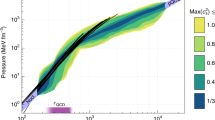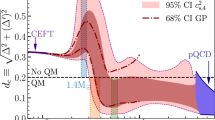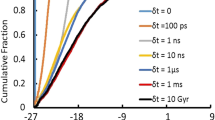Abstract
Blue supergiant stars develop into core-collapse supernovae—one of the most energetic outbursts in the Universe—when all nuclear burning fuel is exhausted in the stellar core. Previous attempts have failed to explain observed explosions of such stars, which have a zero-age main-sequence mass of 50 M⊙ or more. Here, we exploit the largely uncertain state of matter at high density, and connect the modelling of such stellar explosions with a first-order phase transition from nuclear matter to the quark–gluon plasma. The resulting energetic supernova explosions can account for a large variety of light curves, from peculiar type II supernovae to superluminous events. The remnants are neutron stars with a quark matter core, known as hybrid stars, of about 2 M⊙ at birth. A Galactic event of this kind could be observable owing to the release of a second neutrino burst. Its observation would confirm such a first-order phase transition at densities relevant for astrophysics.
This is a preview of subscription content, access via your institution
Access options
Access Nature and 54 other Nature Portfolio journals
Get Nature+, our best-value online-access subscription
$29.99 / 30 days
cancel any time
Subscribe to this journal
Receive 12 digital issues and online access to articles
$119.00 per year
only $9.92 per issue
Buy this article
- Purchase on Springer Link
- Instant access to full article PDF
Prices may be subject to local taxes which are calculated during checkout




Similar content being viewed by others
Data availability
The data that support the plots within this paper and other findings of this study, including the hadron–quark hybrid EOS, are available from the corresponding author upon request.
References
Janka, H.-T., Langanke, K., Marek, A., Martnez-Pinedo, G. & Müller, B. Theory of core-collapse supernovae. Phys. Rep. 442, 38–74 (2007).
Gal-Yam, A. & Leonard, D. C. A massive hypergiant star as the progenitor of the supernova SN 2005gl. Nature 458, 865–867 (2009).
Foley, R. J. et al. The diversity of massive star outbursts. I. Observations of SN2009ip, UGC 2773 OT2009-1, and their progenitors. Astrophys. J. 732, 32 (2011).
Zhang, T. et al. Type IIn supernova SN 2010jl: optical observations for over 500 days after explosion. Astron. J. 144, 131 (2012).
Mauerhan, J. C. et al. The unprecedented 2012 outburst of SN 2009ip: a luminous blue variable star becomes a true supernova. Mon. Not. R. Astron. Soc. 430, 1801–1810 (2013).
Nicholl, M. et al. Slowly fading super-luminous supernovae that are not pair-instability explosions. Nature 502, 346–349 (2013).
Terreran, M. et al. Hydrogen-rich supernovae beyond the neutrino-driven core-collapse paradigm. Nature 1, 713–720 (2017).
Sumiyoshi, K., Yamada, S., Suzuki, H. & Chiba, S. Neutrino signals from the formation of black hole: a probe of equation of state of dense matter. Phys. Rev. Lett. 97, 091101 (2006).
Fischer, T., Whitehouse, S. C., Mezzacappa, A., Thielemann, F.-K. & Liebendörfer, M. The neutrino signal from protoneutron star accretion and black hole formation. Astron. Astrophys. 499, 1–15 (2009).
O’Connor, E. & Ott, C. D. Black hole formation in failing core-collapse supernovae. Astrophys. J. 730, 70 (2011).
Chan, C., Müller, B., Heger, A., Pakmor, R. & Springel, V. Black hole formation and fallback during the supernova explosion of a 40 M ⊙ star. Astrophys. J. 852, L19 (2017).
Woosley, S., Heger, A. & Weaver, T. The evolution and explosion of massive stars. Rev. Mod. Phys. 74, 1015–1071 (2002).
Umeda, H. & Nomoto, K. How much Ni-56 can be produced in core-collapse supernovae? Evolution and explosions of 30–100 M ⊙ stars. Astrophys. J. 673, 1014 (2008).
Antoniadis, J. et al. A massive pulsar in a compact relativistic binary. Science 340, 448 (2013).
Fonseca, E. et al. The NANOGrav nine-year data set: mass and geometric measurements of binary millisecond pulsars. Astrophys. J. 832, 167 (2016).
Liebendörfer, M. et al. A finite difference representation of neutrino radiation hydrodynamics for spherically symmetric general relativistic supernova simulations. Astrophys. J. Suppl. 150, 263 (2004).
Typel, S., Röpke, G., Klähn, T., Blaschke, D. & Wolter, H. Composition and thermodynamics of nuclear matter with light clusters. Phys. Rev. C 81, 015803 (2010).
Danielewicz, P., Lacey, R & Lynch, W. G. Determination of the equation of state of dense matter. Science 298, 1592–1596 2002).
Lattimer, J. M. & Lim, Y. Constraining the symmetry parameters of the nuclear interaction. Astrophys. J. 771, 51 (2013).
Krüger, T., Tews, I., Hebeler, K. & Schwenk, A. Neutron matter from chiral effective field theory interactions. Phys. Rev. C 88, 025802 (2013).
Abbott, B. P. et al. GW170817: observation of gravitational waves from a binary neutron star inspiral. Phys. Rev. Lett. 119, 161101 (2017).
Bazavov, A. et al. Equation of state in (2 + 1)-flavor QCD. Phys. Rev. D 90, 094503 (2014).
Borsányi, S. et al. Full result for the QCD equation of state with 2 + 1 flavors. Phys. Lett. B 730, 99 (2014).
Bazavov, A. et al. The chiral and deconfinement aspects of the QCD transition. Phys. Rev. D 85, 054503 (2012).
Kurkela, A., Fraga, E. S., Schaffner-Bielich, J. & Vuorinen, A. Constraining neutron star matter with quantum chromodynamics. Astrophys. J. 789, 127 (2014).
Farhi, E. & Jaffe, R. Strange matter. Phys. Rev. D 30, 2379 (1984).
Nambu, Y. & Jona-Lasinio, G. Dynamical model of elementary particles based on an analogy with superconductivity. 1. Phys. Rev. 122, 345 (1961).
Takahara, M. & Sato, K. Phase transition in the newly born neutron star and neutrino emission from SN1987A. Prog. Theor. Phys. 80, 861–867 (1988).
Gentile, N. A., Aufderheide, M. B., Mathews, G. J., Swesty, F. D. & Fuller, G. M. The QCD phase transition and supernova core collapse. Astrophys. J. 414, 701 (1993).
Sagert, I. et al. Signals of the QCD phase transition in core-collapse supernovae. Phys. Rev. Lett. 102, 081101 (2009).
Nakazato, K., Sumiyoshi, K. & Yamada, S. Astrophysical implications of equation of state for hadron–quark mixed phase: compact stars and stellar collapses. Phys. Rev. D 77, 103006 (2008).
Kaltenborn, M. A. R., Bastian, N.-U. F. & Blaschke, D. B. Quark–nuclear hybrid star equation of state with excluded volume effects. Phys. Rev. D 96, 056024 (2017).
Horowitz, C. J., Moniz, E. J. & Negele, J. W. Hadron structure in a simple model of quark/nuclear matter. Phys. Rev. D 31, 1689 (1985).
Röpke, G., Blaschke, D. & Schulz, H. Pauli quenching effects in a simple string model of quark/nuclear matter. Phys. Rev. D 34, 3499 (1986).
Klähn, T. & Fischer, T. Vector interaction enhanced bag model for astrophysical applications. Astrophys. J. 810, 134 (2015).
Benić, S., Blaschke, D., Alvarez-Castillo, D. E., Fischer, T. & Typel, S. A new quark–hadron hybrid equation of state for astrophysics—I. High-mass twin compact stars. Astron. Astrophys. 577, A40 (2015).
De, S. et al. Constraining the nuclear equation of state with GW170817. Phys. Rev. Lett. 121, 091102 (2018).
Bethe, H. A. & Wilson, J. R. Revival of a stalled supernova shock by neutrino heating. Astrophys. J. 295, 14 (1985).
LeBlanc, J. M. & Wilson, J. R. A numerical example of the collapse of a rotating magnetized star. Astrophys. J. 161, 541 (1970).
Bisnovatyi-Kogan, G. S., Popov, I. P. & Samokhin, A. A. The magnetohydrodynamic rotational model of supernova explosion. Astrophys. Space Sci. 41, 287–320 (1976).
Bruenn, S. W. et al. Axisymmetric ab initio core-collapse supernova simulations of 12–25 M ⊙ stars. Astrophys. J. 767, L6 (2013).
Müller, B., Janka, H.-Th & Marek, A. A new multi-dimensional general relativistic neutrino hydrodynamics code for core-collapse supernovae. II. Relativistic explosion models of core-collapse supernovae. Astrophys. J. 756, 84 (2012).
Suwa, Y. et al. On the importance of the equation of state for the neutrino-driven supernova explosion mechanism. Astrophys. J. 764, 99 (2013).
Melson, T., Janka, H.-Th & Marek, A. Neutrino-driven supernova of a low-mass iron-core progenitor boosted by three-dimensional turbulent convection. Astrophys. J. 801, L24 (2015).
Wu, M.-R., Fernández, R., Martnez-Pinedo, G. & Metzger, B. D. Production of the entire range of r-process nuclides by black hole accretion disc outflows from neutron star mergers. Mon. Not. R. Astron. Soc. 463, 2323–2334 (2016).
Smith, N. et al. SN 2006gy: discovery of the most luminous supernova ever recorded, powered by the death of an extremely massive star like η Carinae. Astrophys. J. 666, 1116 (2007).
Moriya, T. J. et al. Light-curve modelling of superluminous supernova 2006gy: collision between supernova ejecta and a dense circumstellar medium. Mon. Not. R. Astron. Soc. 428, 1020–1035 (2013).
Mirizzi, A. et al. Supernova neutrinos: production, oscillations and detection. Riv. Nuovo Cimento 39, 1–112 (2016).
Dasgupta, B. et al. Detecting the QCD phase transition in the next Galactic supernova neutrino burst. Phys. Rev. D 81, 103005 (2010).
Tauris, T., Langer, N. & Kramer, M. Formation of millisecond pulsars with CO white dwarf companions—I. PSR J1614-2230: evidence for a neutron star born massive. Mon. Not. R. Astron. Soc. 416, 2130–2142 (2011).
Tauris, T., Langer, N. & Kramer, M. Formation of millisecond pulsars with CO white dwarf companions—II. Accretion, spin-up, true ages and comparison to MSPs with He white dwarf companions. Mon. Not. R. Astron. Soc. 425, 1601–1627 (2012).
Sukhbold, T., Ertl, T., Woosley, S. E., Brown, J. M. & Janka, H.-T. Core-collapse supernovae from 9 to 120 solar masses based on neutrino-powered explosions. Astrophys. J. 821, 45 (2016).
Paczyński, B. Evolutionary processes in close binary systems. Annu. Rev. Astron. Astrophys. 9, 183 (1971).
Özel, F., Psaltis, D., Narayan, R. & Santos Villarreal, A. On the mass distribution and birth masses of neutron stars. Astrophys. J. 757, 55 (2012).
Antoniadis, J. et al. The millisecond pulsar mass distribution: evidence for bimodality and constraints on the maximum neutron star mass. Preprint at https://arxiv.org/abs/1605.01665 (2016).
Mezzacappa, A. & Bruenn, S. A numerical method for solving the neutrino Boltzmann equation coupled to spherically symmetric stellar core collapse. Astrophys. J. 405, 669 (1993).
Liebendoerfer, M., Rosswog, S. & Thielemann, F.-K. An adaptive grid, implicit code for spherically symmetric, general relativistic hydrodynamics in comoving coordinates. Astrophys. J. Suppl. 141, 229 (2002).
Wu, M.-R., Qian, Y.-Z., Martnez-Pinedo, G., Fischer, T. & Huther, L. Effects of neutrino oscillations on nucleosynthesis and neutrino signals for an 18 M ⊙ supernova model. Phys. Rev. D 91, 065016 (2015).
Scholberg, K. Supernova neutrino detection. Annu. Rev. Nucl. Part. Sci. 62, 81–103 (2012).
Patrignani, C. et al. (Particle Data Group) Review of particle physics. Chin. Phys. C 40, 100001 (2016).
Blinnikov, S. I. et al. Theoretical light curves for deflagration models of type Ia supernova. Astron. Astrophys. 453, 229–240 (2006).
Sorokina, E. I., Blinnikov, S. I., Nomoto, K., Quimby, R. & Tolstov, A. Type I superluminous supernovae as explosions inside non-hydrogen circumstellar envelopes. Astrophys. J. 829, 17 (2016).
Acknowledgements
The authors are grateful to K.-J. Chen for discussions about possible implications regarding the supernova light curve, H. Umeda for details of the stellar model used in this work, and A. Yudin for helpful discussions regarding neutrino processes. The supernova simulations were performed at the Wroclaw Center for Networking and Supercomputing. The authors acknowledge support from the Polish National Science Center under grant numbers UMO-2016/23/B/ST2/00720 (to T.F. and N.-U.F.B.) and DEC-2011/02/A/ST2/00306 (to T.F., N.-U.F.B. and D.B.B.), Russian Science Foundation under grant numbers 16–12–10519 (to P.B. and E.S.) and 18–12–00522 (to S.B.) and Ministry of Science and Technology (Taiwan) under grant number 107-2119-M-001-038 (to M.-R.W.). D.B.B. is further supported by the MEPhI Academic Excellence Project under contract number 02.a03.21.0005, and S.T. acknowledges the DFG through grant SFB1245. This work was supported by the COST Actions CA15213 (THOR), CA16117 (ChETEC) and CA16214 (PHAROS).
Author information
Authors and Affiliations
Contributions
All authors discussed the results and commented on the manuscript. T.F. wrote the paper, implemented the hadron–quark EOS in the supernova model, performed all the supernova simulations and analysed the corresponding results. N.-U.F.B., D.B.B. and T.K. developed the new quark EOS and the extension to finite temperatures and arbitrary isospin asymmetry. S.T. provided the hadronic EOS selected for this study. M.-R.W. performed the neutrino detection analysis and nucleosynthesis calculations for the prediction of the elemental yields. P.B., E.S. and S.B. performed the light curve analysis. All authors commented on the manuscript draft.
Corresponding author
Ethics declarations
Competing interests
The authors declare no competing interests.
Additional information
Publisher’s note: Springer Nature remains neutral with regard to jurisdictional claims in published maps and institutional affiliations.
Supplementary information
Supplementary Information
Supplementary Figures 1–2, Supplementary text, Supplementary references
Rights and permissions
About this article
Cite this article
Fischer, T., Bastian, NU.F., Wu, MR. et al. Quark deconfinement as a supernova explosion engine for massive blue supergiant stars. Nat Astron 2, 980–986 (2018). https://doi.org/10.1038/s41550-018-0583-0
Received:
Accepted:
Published:
Issue Date:
DOI: https://doi.org/10.1038/s41550-018-0583-0
This article is cited by
-
QCD equations of state and speed of sound in neutron stars
AAPPS Bulletin (2021)
-
Progress in nuclear astrophysics of east and southeast Asia
AAPPS Bulletin (2021)



